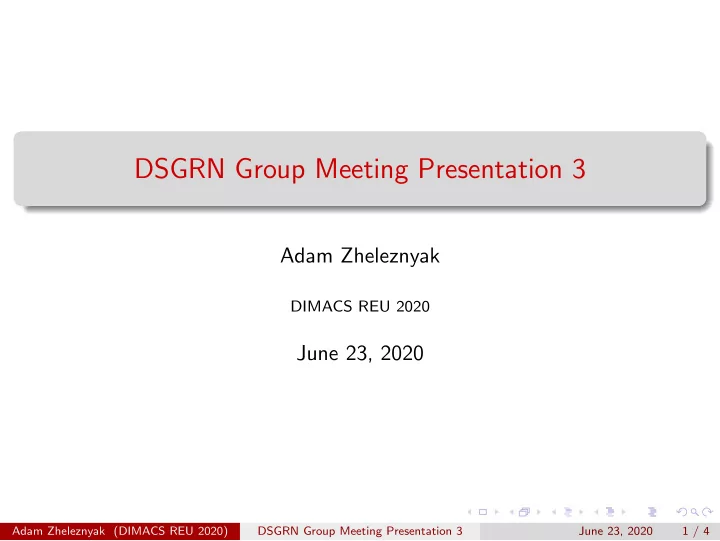

DSGRN Group Meeting Presentation 3 Adam Zheleznyak DIMACS REU 2020 June 23, 2020 Adam Zheleznyak (DIMACS REU 2020) DSGRN Group Meeting Presentation 3 June 23, 2020 1 / 4
Problem Take an interaction function f ( z 1 , . . . , z n ) and let P m := { f ( z 1 , . . . , z n ) : z i = ℓ i , ℓ i + δ (1) , . . . , or ℓ i + δ (1) + · · · + δ ( m − 1) , ∀ i } i i i P m ⊂ R [ ℓ 1 , . . . , ℓ n , δ (1) 1 , . . . , δ (1) n , . . . , δ ( m − 1) , . . . , δ ( m − 1) ] ( nm variables) n 1 Adam Zheleznyak (DIMACS REU 2020) DSGRN Group Meeting Presentation 3 June 23, 2020 2 / 4
Problem Take an interaction function f ( z 1 , . . . , z n ) and let P m := { f ( z 1 , . . . , z n ) : z i = ℓ i , ℓ i + δ (1) , . . . , or ℓ i + δ (1) + · · · + δ ( m − 1) , ∀ i } i i i P m ⊂ R [ ℓ 1 , . . . , ℓ n , δ (1) 1 , . . . , δ (1) n , . . . , δ ( m − 1) , . . . , δ ( m − 1) ] ( nm variables) n 1 We want to find T ( P m , ≺ m , (0 , ∞ ) mn ), which is all the realizable orderings of polynomials in P m . i.e We want to find the orderings for which there exists some positive values for ℓ 1 , . . . , ℓ n , δ (1) 1 , . . . , δ (1) n , . . . , δ ( m − 1) which places the 1 polynomials into that order when evaluated. Adam Zheleznyak (DIMACS REU 2020) DSGRN Group Meeting Presentation 3 June 23, 2020 2 / 4
Example of lattice being extended Isomorphic to the lattice of points on a subset of the coordinate plane ordered component-wise. Adam Zheleznyak (DIMACS REU 2020) DSGRN Group Meeting Presentation 3 June 23, 2020 3 / 4
Results so far At least in the linear case, this problem can use the same algorithm as used before, but there could be the limiting factor of the number of solutions growing very quickly as m or n grows larger. Adam Zheleznyak (DIMACS REU 2020) DSGRN Group Meeting Presentation 3 June 23, 2020 4 / 4
Results so far At least in the linear case, this problem can use the same algorithm as used before, but there could be the limiting factor of the number of solutions growing very quickly as m or n grows larger. In a certain sense: T ( P m − 1 , ≺ m − 1 , (0 , ∞ ) ( m − 1) n )“ ⊂ ” T ( P m , ≺ m , (0 , ∞ ) mn ) So in theory, there is a clever way to create/store a database for T ( P m , ≺ m , (0 , ∞ ) mn ) such that solutions for lesser m can be quickly found as well Adam Zheleznyak (DIMACS REU 2020) DSGRN Group Meeting Presentation 3 June 23, 2020 4 / 4
Results so far At least in the linear case, this problem can use the same algorithm as used before, but there could be the limiting factor of the number of solutions growing very quickly as m or n grows larger. In a certain sense: T ( P m − 1 , ≺ m − 1 , (0 , ∞ ) ( m − 1) n )“ ⊂ ” T ( P m , ≺ m , (0 , ∞ ) mn ) So in theory, there is a clever way to create/store a database for T ( P m , ≺ m , (0 , ∞ ) mn ) such that solutions for lesser m can be quickly found as well Possible next step: Create code to handle the linear case and see how many solutions there can be. Adam Zheleznyak (DIMACS REU 2020) DSGRN Group Meeting Presentation 3 June 23, 2020 4 / 4
Recommend
More recommend